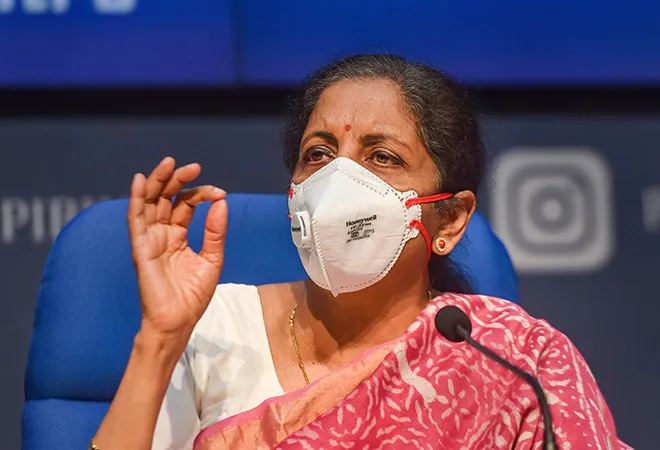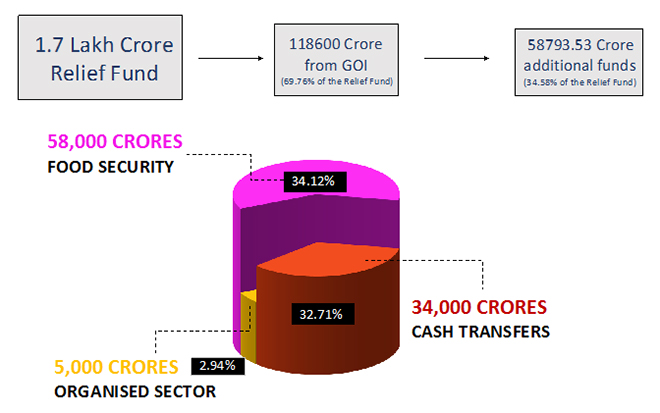-
CENTRES
Progammes & Centres
Location

In the midst of the coronavirus pandemic came the union government’s promise to relieve the citizens of India of the economic burden that has befallen them owing to what looked like an indefinite lockdown. The first relief came in the form of a welfare package promising to allocate a sum of ₹1.7 lakh crores for the most vulnerable parts of the population, namely, the rural and urban poor, the disadvantaged, and women.
The center’s decision to impose a lockdown early in a bid to flatten the curve brought life to an unprecedented halt, and the bailout effort from the government amounted to a dismal 0.83% of the GDP<1> - as compared to 10% by USA and 5% by Canada.
The echoing sounds of disappointment from economists and the civil society about the inappreciable relief package prompted another series of stimuli, this time allegedly amounting to 10% of the GDP, in the name of Atmanirbhar Bharat.
While Atmanirbhar Bharat seems like a great narrative to push in a time when many global supply chains have been suspended, the fact is that the fiscal stimulus comes out to be around 1% of the GDP in terms of government spending, according to most economists. This has caused a huge furor among the masses, and rightly so, but the fact remains that the first relief package had gaping holes in it that the second package failed to seal.
Given that over 90% of India’s labor force works in the informal sector, earning less than $3 a day, and over 9 million migrants crossing borders for work, it’s hard to believe that the government thought this through.
The first wave of disappointment comes from 35% of the allocations under the PMGKY relief fund being rewrapped and repackaged from the union budget of FY2020-21 and passed off as new spending. India has also secured an additional loan of $1 billion (approximately 7,500 crores) from the World Bank to fund its relief package.
 * The figures are total funds allocated as a percent of the total relief fund
* The figures are total funds allocated as a percent of the total relief fund
Amount from 2020-21 Union Budget = ₹38206.47 Crores
(22.47% of the relief package)
Amount of New Spending = ₹19793.53 Crores
(11.64% of the relief package)
 The biggest slice of the pie went towards food security allocating ₹45,000 crore. The union budget of 2020-21 estimates the annual food subsidy budget to be ₹28892.42 crores per quarter. There is a 55.75% increase in the expenditure, amounting to ₹16,107.58 crore. Similarly, the package promises to supply LPG cylinders incurring a cost of 13,000, which corresponds to a 39.57%<2> increase in the LPG subsidy budget of the center. This was definitely a step in the right direction as it went towards securing the base of Maslow’s pyramid and hedged the poor against food inflation. But as millions of starving people are barely hanging by a thread, the FCI godowns are still overflowing with stocks of food grain. According to the Ministry of Consumer Affairs, Food & Public Distribution, a total of 630.10 LMT food grain stock is still available in May out of which, only about 60 LMT food grains is required for a month under NFSA and other welfare schemes.
The biggest slice of the pie went towards food security allocating ₹45,000 crore. The union budget of 2020-21 estimates the annual food subsidy budget to be ₹28892.42 crores per quarter. There is a 55.75% increase in the expenditure, amounting to ₹16,107.58 crore. Similarly, the package promises to supply LPG cylinders incurring a cost of 13,000, which corresponds to a 39.57%<2> increase in the LPG subsidy budget of the center. This was definitely a step in the right direction as it went towards securing the base of Maslow’s pyramid and hedged the poor against food inflation. But as millions of starving people are barely hanging by a thread, the FCI godowns are still overflowing with stocks of food grain. According to the Ministry of Consumer Affairs, Food & Public Distribution, a total of 630.10 LMT food grain stock is still available in May out of which, only about 60 LMT food grains is required for a month under NFSA and other welfare schemes.
The second relief package promises to allocate food grains to migrants and non-ration card holders. Providing free ration to the migrants is a long-awaited step but how is the assistance meant to reach the beneficiaries when they are scattered across different highways in the country miles away from, both, their workplaces and destination.
Amount from 2020-21 Union Budget = ₹21,600 Crores
(12.71% of the relief package)
Amount of New Spending = ₹34,000 Crores
(20% of the relief package)

The package included cash transfers to farmers, rural laborers, and other existing transfer beneficiaries like women Jan Dhan Account holders, elderly, etc. It frontloaded ₹2,000 to farmers under the PM Kisan scheme which is a part of a larger pool of fund of ₹6,000 already budgeted under the union budget and corresponds to no additional relief (zero percent increase) accorded to farmers.
For Rural laborers, the 11% increase in MNREGA wages from ₹182 to ₹202 came in addition to the second relief stimulus, which increased MNREGA budget to 40,000 crores. This seems like a step in the right direction for job creation as previous year figures for employment guarantee look quite dismal. In FY 2019-20, only 6.87% of the total households under NREGA completed the 100-day mark.<3> Still, it is of utmost importance that rural laborers are added to the list of direct transfer beneficiaries.
For other existing beneficiaries like senior citizens, widows, and disabled, the new allotment gave a meagre sum of approximately ₹333/month to each category which corresponds to an increase of more than 100% for most groups (except beneficiaries aged above 80, 66.6% increase for them). The cash transfers are far from adequate at a time when income has been completely knocked out. The lockdown imposes a huge strain on poor households, and the center needs to step up and loosen the fiscal purse strings to make sure the most vulnerable can sustain these economic shocks.
The second relief package, or fiscal stimulus, fails to enhance the cash transfers to the poor.
Amount from 2020-21 Union Budget = ₹0
Amount of New Spending = ₹5,000 Crore
(2.94% of the relief package)
 For PF holders, the Government of India proposed to pay 24% of monthly wages for those earning less than ₹15,000 in establishments which have up to 100 employees and make available a non-refundable advance of 75% or 3-months wages, whichever is lower.
For PF holders, the Government of India proposed to pay 24% of monthly wages for those earning less than ₹15,000 in establishments which have up to 100 employees and make available a non-refundable advance of 75% or 3-months wages, whichever is lower.
While the former is a welcome move as it takes some of the burden away from employers to contribute to the EPF, thereby trimming the need to lay-off workers, the provision of a non-refundable advance from the PF account is not the most sound move as it will dig into the savings of the employees, making a big gaping hole in their future security.
Amount from 2020-21 Union Budget = ₹0
Amount of New Spending = ₹0
Construction worker Welfare Fund = ₹31,000 Crore
Affordable rental housing complexes for migrants = No details yet
For registered construction workers, the union government has instructed States to use ₹31,000 crore from the cess fund for welfare of construction workers. Interestingly, this came two days after the ministry of Labor on 24th March announced that the welfare fund amounts to approximately ₹52,000 crore. The discrepancy in the two announcements begs the question of frugal allocation of funds when it is most needed by the construction workers, now stranded and out of work. What’s even more interesting is that only Rs 3492.57 crore have been allocated so far, which is only 14% of the promised amount and 8.3% of the total money accumulated in the fund. Not only is the center unwilling to spend its own money for social protection, it’s also hesitant to distribute benefits of a fund created for these beneficiaries. The money could have been used to get construction workers home safely and early.
There have been two major accidents, and plenty isolated cases, involving migrants which have resulted in deaths. The prime minister cares enough about the current plight faced by the migrant workers to ensure big builders of their return to the work states by luring them with affordable future rental housing complexes in cities, but not enough to ensure their safe return to their homes. There has been no mention by the prime minister of the tragedy ensuing the migrant workers, barring some 280 characters on Twitter.
The current crisis was termed ‘the worst global crisis since World War II’ by the International Labor Organization (ILO) in a recent report and the measures need to be commensurate. The report further claims that more than 40 crore informal sector workers are vulnerable to be pushed deeper into the poverty cycle.
There is an immediate need to establish a universal basic income scheme with far greater reach than the current DBT scheme affords. This would go a long way in insuring we don’t leave behind the poor in our fight for survival. The current relief, paltry at worst and inadequate at best, just doesn’t work.
Now the finance minister is trying to push reforms in place of aid. One has to admit that structural reforms are required by the Indian economy, but how is it helping the poor ride the tides of covid-19?
The Pradhan Mantri Garib Kalyan Yojana Composition
<1> GDP figure corresponds to the second advanced estimated of nominal GDP for FY2019-20 as reported by NSO, Ministry of Statistics and Program Implementation
<2> The union budget of 2020-21 estimates the annual LPG subsidy budget of crores, which corresponds to 9314.05 crores per quarter. The additional food spending is 3685.95 crores which is a 55.75% increase in the budget.
<3> In FY 2019-20, the average days of employment provided per HH was 47.87 and only a total of 36,30,658 HH worked full 100 days out of 5.43 crore HH that worked, which is a mere 6.87%.
The views expressed above belong to the author(s). ORF research and analyses now available on Telegram! Click here to access our curated content — blogs, longforms and interviews.